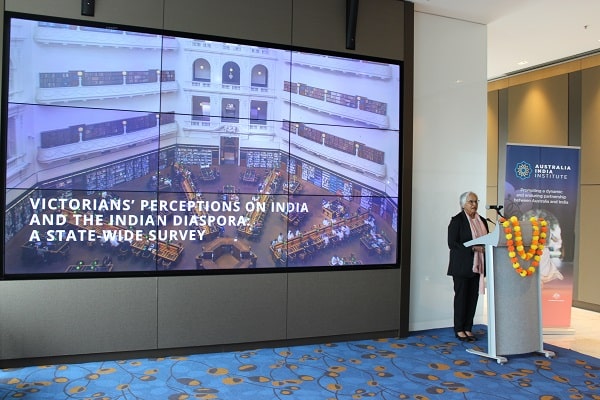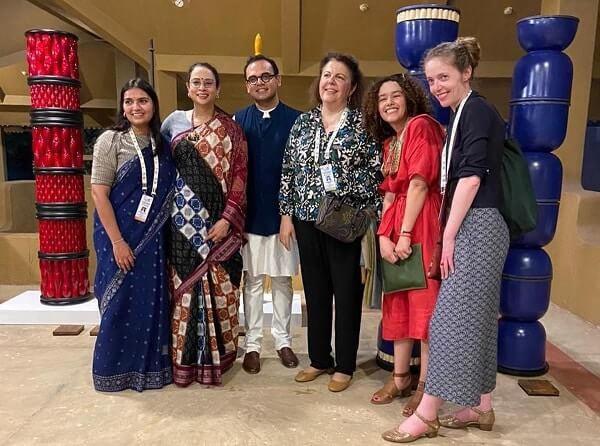A recent study by the Australia India Institute on mainstream Victorians’ perceptions about the Indian community largely confirms what is generally understood: that overall, the perceptions are positive; that the community is seen as making substantial contributions, and that despite this, its members face difficulties in crashing through the glass ceiling at work.
The AII study, titled Victorians’ Perceptions on India and the Indian Diaspora investigated perceptions of Indian migrants state-wide, with respect to their contributions to the local society, economy, and culture.
Its findings will help understand a “burgeoning part of the Victorian community and shape policy discussions to promote a more inclusive Victoria,” the Institute’s chief executive Lisa Singh said.

Navigating barriers to leadership
Perhaps the most significant outcome from the AII survey was the lack of visibility of Indian-origin Australians in leadership positions. This, despite the increasing number of Indian-origin CEOs in the corporate world (known now as India’s ‘most significant‘ export) and an increasing number of politicos, although that’s in neighbouring NSW.
81% of survey respondents were unaware of Indian diaspora members holding leadership roles in business or politics in Victoria. This lack of awareness was particularly pronounced among individuals aged over 45 years, females, and those with education below tertiary levels. Moreover, over 80% either did not know or did not believe that Indian Australians are adequately represented in leadership positions.
Singh, herself a leader of Indian descent with a successful stint in politics as well as corporate, agreed that this ignorance underscores the urgent necessity for enhancing the visibility and recognition of the leadership capabilities of Indian-Australians.
“This presents an opportune moment to leverage the global spotlight on India and advance discussions on how the Australia-India bilateral relationship can catalyse positive change,” she told Indian Link.
Discussing strategies and initiatives crucial for their integration and contribution to Australian society, Lisa Singh observed, “Our Indian diaspora networks have become a dynamic and enterprising part of the fabric of Victorian society. Their roles in being gateways to greater opportunities for social and economic collaboration in Victoria are held in high regard.”
During periods of national crisis, such as the 2019 bushfires and the COVID-19 pandemic, members of the Indian diaspora showed leadership and responsibility by organising missions to distribute essential supplies, volunteering services, providing medical aid, and establishing vaccination drives. Some of these initiatives continue to make the news even today. Members of Parliament and local representatives regularly make reference to these in their public addresses, but it appears the general public remains unaware.

Engagement with the Indian diaspora
Despite the obstacles in leadership advancement, Victorians continue to engage actively with the Indian diaspora, acknowledging their significant contributions across various sectors. A substantial 71% of Victorian respondents reported regular interactions with the Indian diaspora in Victoria, with encounters predominantly occurring in retail/restaurant (58%) and work settings (56%). Furthermore, 51% of respondents across all age and gender groups agreed that the diaspora contributes positively to their local community.
Empowering Indian International students
Indian international students are integral to Victoria’s academic landscape and economy, the survey revealed.
Almost 60% of respondents believed that Indian international university students make a positive contribution to Victoria’s economy and society, with more than half expressing a keen interest in learning more about India and participating in future Indian public and cultural events.
Specifically, 58% of Victorian survey participants agreed that international Indian university students play a positive role in Victoria’s economy and society, a sentiment particularly strong among highly educated and employed males aged 25-64 years. However, challenges persist in ensuring their seamless integration into the workforce post-graduation.
Regarding employment, 48% of respondents were unaware of whether Victorian businesses have hired Indian international students in the past five years. Additionally, 28% of those in business reported they had not hired Indian international students or graduates themselves, while 24% were aware of businesses that did so.
Government initiatives and collaboration
The Indian diaspora in Victoria comprises skilled migrants who are highly educated and actively contribute to key economic sectors essential for the state’s trade expansion. A significant majority of survey respondents advocated for the Victorian Government to capitalise on this talent pool, recognising its pivotal role in encouraging more skilled migration from India.
Seventy per cent of respondents endorsed the idea of the Victorian Government engaging with India to promote trade and business, while 60% emphasised the importance of the government’s role in facilitating skilled migration from India. Additionally, most respondents recognised the significance of the government’s efforts in promoting travel and tourism (59%) and supporting cultural events (52%) to foster person-to-person relations between Victoria and India.

Bridging the divide
Speaking at the launch, Ingrid Stitt, Minister for Multicultural Affairs said, “It’s important that we continue to see an increase of Indian Victorians in leadership roles, that we continue to promote cultural awareness of India and that we pursue opportunities to support relevant work pathways for international students so that they can get jobs in the fields they are studying.”
She added, “The Victorian Government will continue its work building economic, cultural and social ties with India.”
India has emerged as a leading diaspora community in Australia, surpassing the UK and China in contributing the highest number of permanent migrants during 2021-2022.
Approximately 40% of Indian migrants opt to settle in the state of Victoria, where they actively participate in key economic sectors. This demographic represents a youthful migrant cohort actively engaged in key economic sectors within the state. Among Victoria’s Indian diaspora, 64% hold Australian citizenship, while 36% are second-generation individuals fluent in English and multiple languages, embodying the diverse linguistic and cultural fabric of Victorian-Indians.
The survey was conducted in collaboration with Roy Morgan’s Taking the Pulse of the Nation (TTPN) and The Melbourne Institute of Applied Economics and Social Research.
More than 2,500 Victorians across urban, regional, and rural locations were surveyed over two years.
Read More: Scanlon Institute report: Indian-Australians feel strong belonging




